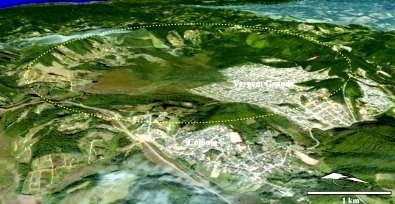


Spherules were discovered in the sediments present at depths of 180-224 m inside the crater located in São Paulo, Brazil. Their shape suggests local rock was pulverized, nebulized, and expelled upward by the collision (photo: Victor Velázquez Fernandez)
Published on 08/15/2022
José Tadeu Arantes | Agência FAPESP – The Colônia crater is a geological formation located in Parelheiros, a suburb in the south of São Paulo less than 40 km from the center of Brazil’s most populous city. It has a diameter of about 3.6 km and is some 300 m deep, with an uplifted rim of 120 m. Over time, intense weathering and sedimentation filled the hole almost completely, and its rim became covered with vegetation, resulting in a flat area surrounded by hills that remained hidden until the early 1960s, when aerial photographs and satellite imagery revealed its almost perfectly circular shape.
In 2013, it was recognized as an impact crater caused by an extraterrestrial body, through microscopic analysis of sediments collected at different depths.
This study and later ones were conducted by geologist Victor Velázquez Fernandez, a professor at the University of São Paulo's School of Arts, Sciences and Humanities (EACH-USP), as reported at various times by Agência FAPESP.
A new study by Velázquez has found even more robust evidence of the impact that produced the crater. An article about it is published in Solid Earth Sciences with the title “Morphological aspects, textural features and chemical composition of spherules from the Colônia impact crater, São Paulo, Brazil”.
“We found spherules inside the crater at depths of between 180 m and 224 m, with shapes that can be explained only by the impact of an extraterrestrial body that produced temperatures on the order of 5,000 degrees Celsius and pressure of 40 kilobars, equivalent to 40,000 times the standard atmospheric pressure,” Velázquez said.
The fact that the spherules were found inside and not outside the crater is striking, as the impact should have ejected sediment. “Our explanation is that the energy of the impact transformed the rocks at the site into a dense, superheated cloud. This material was expelled upward, froze, and fell back to the bottom of the recently formed crater,” he said.
The size of the spherules ranges from 0.1 mm to 0.5 mm along their longest axis, with 0.4 mm prevailing. As for shape, 44% are oval, 30% resemble droplets, 18% are spherical, and 8% are prolate (spindle-shaped ellipsoid). The rest do not match these classifications.
“It’s significant that they aren’t all spherical because this means they can’t be classified as micrometeorites, which are always spherical owing to friction with the atmosphere. The oval, prolate and droplet shapes are especially relevant because they can only be explained by our hypothesis that the impact caused a superheated cloud with vertical ejection, after which the material solidified and fell back into the crater,” Velázquez said.
Another important finding of this new study is that the chemical composition of the spherules is consistent with that of the rocks in the crater’s rim. “There are many elements, but the significant ones are silicon, aluminum, chromium and nickel. The lack of evidence that they received material from the object that landed on the site strongly suggests that the object was a comet and not a metallic or rocky asteroid,” he explained.
More research will be needed before it can definitely be concluded that the object was a comet, however. “Although we don’t know its size, velocity or incidence angle, a comparison with other impact craters suggests the devastation produced by the collision was 20 km in radius,” Velásquez said. “Another thing we don’t know is the date of the event, which for now we estimate as between 5 million and 30 million years ago.”
The study was supported by FAPESP via two regular grants: the first on the registration of geological and geomorphological elements from the Colônia crater; and the second on geological registers in the region granted to Velásquez.
The article “Morphological aspects, textural features and chemical composition of spherules from the Colônia impact crater, São Paulo, Brazil” is at: https://www.sciencedirect.com/science/article/pii/S2451912X20300635.
Source: https://agencia.fapesp.br/39360